It looks like you're using an Ad Blocker.
Please white-list or disable AboveTopSecret.com in your ad-blocking tool.
Thank you.
Some features of ATS will be disabled while you continue to use an ad-blocker.
share:
I find the jewelled skeletons of central Europe from the Counter Reformation period fascinating some i'll share some. They could take up to five
years to produce and thousands were spent on the decorations of gold and jewells, which were supposed to give insight into the riches that awaited in
Heaven, they all have great stories to tell, in that they were found in the Roman Catacombs and then had to be identified, granted a certificate of
authenticity and sent Northwards.
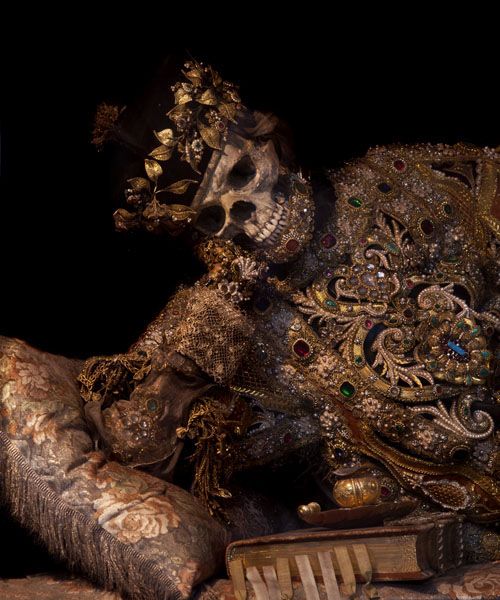
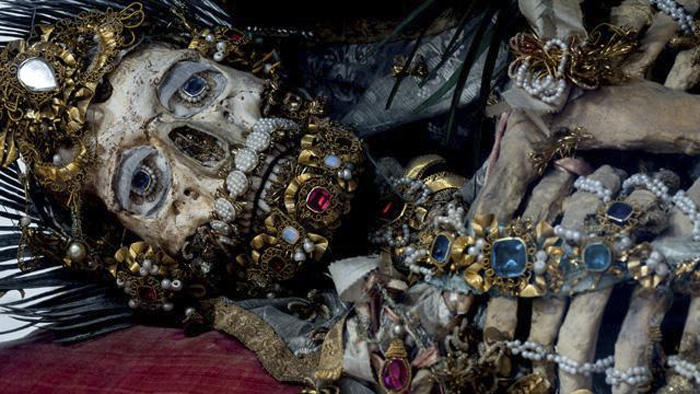
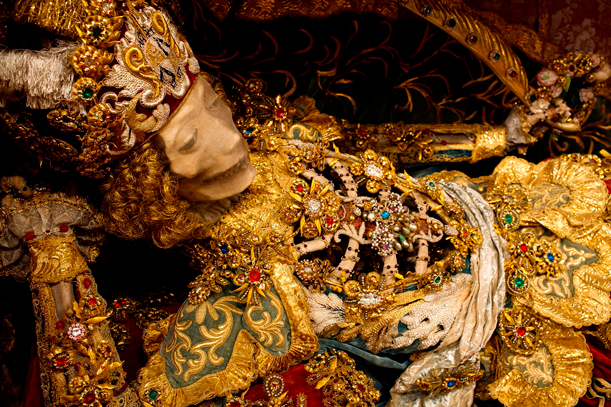
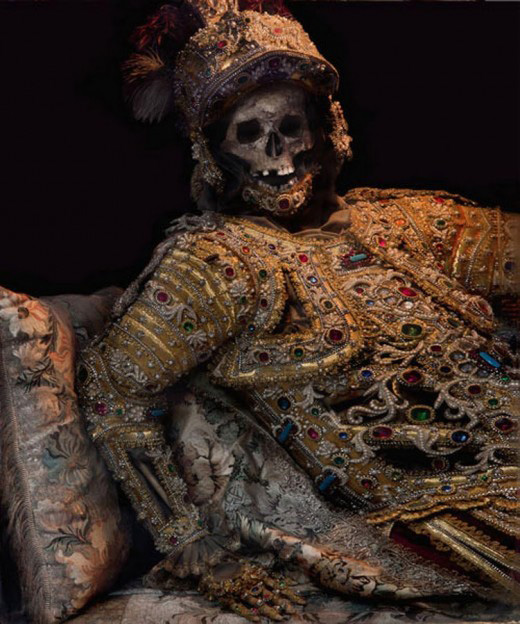
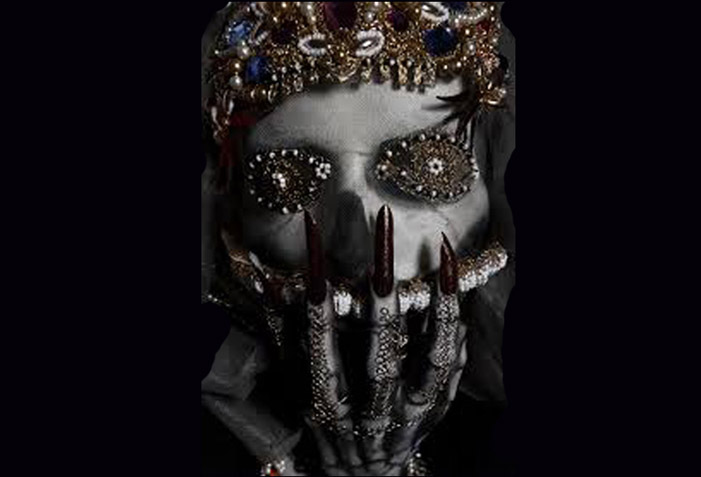
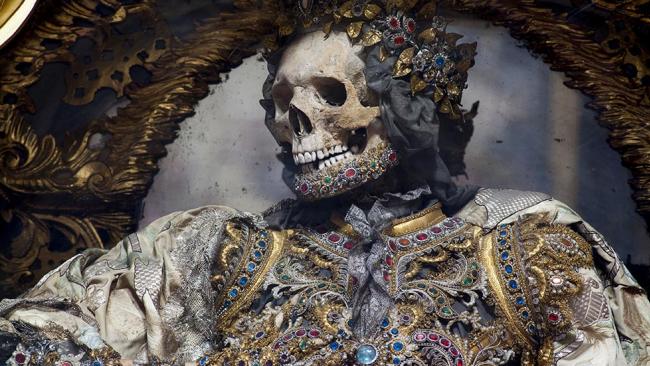
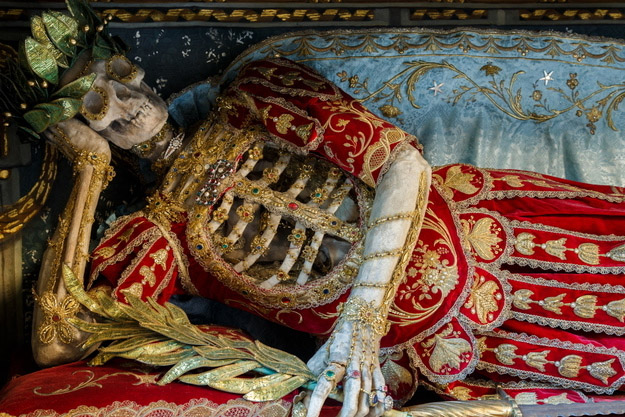
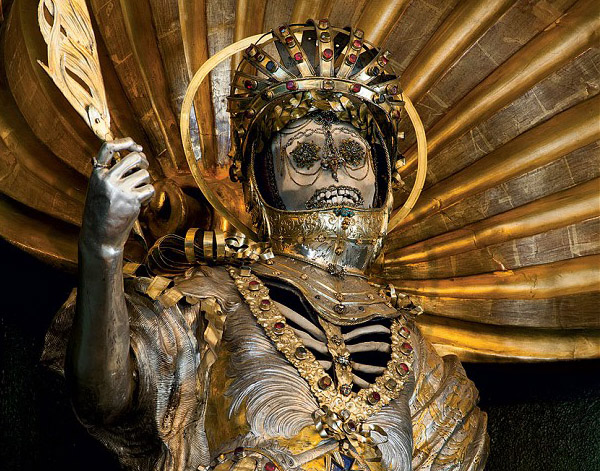
I know skeletons in bling aren't everyone's thing but i enjoy looking at them in terms of the creativity involved, seems a shame many are now hidden away out of sight, they'd be great paraded around the towns in torchlit procession
The most beautiful dead
Bones with Bling
The identification of the skeleton in Rott-am-Inn as the Emperor Constantine is dubious, but he is only one of several such skeletons, usually found in small parochial churches in Germany and Switzerland, fully articulated and covered over with gold, silver, and gems. They represent a curious and largely forgotten piece of Catholic history from a time when clairvoyant priests would use their powers to ascertain the remains of saints and martyrs.

The trend for jewelled skeletons began in the late 16th century. The Roman catacombs, which had been abandoned as burial sites and largely forgotten about, were rediscovered in 1578 by vineyard workers. This coincided with the initial phase of the Counter-Reformation; one of the areas of concern was affirming the efficacy and belief in relics against attacks by their detractors. Since the remains in the catacombs dated from the second to fifth centuries AD, it was possible, with a bit of wishful thinking, for Church leaders to romanticise the bones as belonging to almost any famed early Christian saint or martyr. In the newfound cache they saw a potential tool to bolster their supply of relics and promote their power.

The arrival of St. Albertus’ remains from the Roman Catacombs in 1723 was a source of great excitement for the parishioners of the church of St. George in Burgrain, Germany, offering both a tangible connection to the early Christian martyrs and a glimpse of the heavenly treasures that awaited the faithful.

They were sent to Catholic churches and religious houses to replace the relics destroyed in the wake of the Protestant Reformation in the 1500s St. Luciana arrived at the convent in Heiligkreuztal, Germany, in the mid- 18th century and was prepared for display by the nuns in Ennetach

In reality, the bones could have belonged to anyone, since very few were provided with specific, identifying information – skeletons from the catacombs could, in fact, be pagan as easily as Christian. Papal secretaries were assigned to authenticate any potential relics, and the requirements were lax – frequently it was necessary only to find a palm on a coffin, or a bit of dried blood. Either was considered a sufficient emblem of a Christian martyr. More problematic was the issue of determining individual identities for the presumed holy personages. For that, a higher power was needed – psychic communion, involving clerical mediums who would descend into the catacombs and ascertain the identities of the skeletons. The practice continued until the mid-19th century, sometimes even involving the Pope himself, if he too had clairvoyant abilities.

To augment the supply of relics, he explained, trips were periodically made to the catacombs, but no one had a clue as to the identity of the skeletons found there, or if they were even Christian. Pope Gregory XVI would descend into the subterranean passages accompanied by a group of priests, invoke the Holy Ghost, and read a prayer, “by which Divine assistance, and directions from on high, is sought for the performance of this… solemn duty. The Pope then casts his eyes around the confused mass of mouldering skeletons, and, as the whim may take him, calls this the body of saint such-a-one, another, the body of ‘Virgin some-other-one’ – and so on, till he is warned by his attendants that enough are now baptized… to serve for the present occasion.

here was also the awkward issue of skeletons being divined as the relics of someone whose bones were already known to be in the possession of the Church. The Church of St Nicholas in Wil, Switzerland, for example, possesses the striking armoured and jewelled skeleton of the third-century martyr St Pancratius, taken from the catacombs in the 17th century. The relics of Pancratius, however, were already claimed to be housed in Rome, in a basilica that bore his name.Nonetheless, Pope Clement X and his staff confirmed the identity of the second skeleton as also being Pancratius

The most famous of all the artists who worked on such skeletons, Adalbart Eder at Waldsassen, was known for his ability to commune directly with the bones. The Basilica at Waldsassen possesses more jewelled skeletons than any church in Europe – a total of 10, lining the nave, as well as two large bust reliquaries on the altar – and these were all decorated during the 18th century by Eder, a Cistercian lay brother and skilled goldsmith. The last of these, the martyr Maximus, stumped Eder with its silence. According to local records, Eder, unable to communicate with it, was driven to the verge of despair in his inability to find an adequate posture for the skeleton. Called to supper, the frustrated artist informed the skeleton that he simply did not know what to do with it, and left his cell; when he returned, the skeleton had positioned itself.

I know skeletons in bling aren't everyone's thing but i enjoy looking at them in terms of the creativity involved, seems a shame many are now hidden away out of sight, they'd be great paraded around the towns in torchlit procession
The most beautiful dead
Bones with Bling
edit on
Kam531129vAmerica/ChicagoSaturday1031 by Kantzveldt because: (no reason given)
Yeah I went to one of the 'bone churches' in the former Czechoslovakia ......very creepy
Kostnice, hutna hora or ossuary
Kostnice, hutna hora or ossuary
Absolutely strange and haunting to look through, a good article too - thanks for bringing it to our attention. I really don't know whether to be
amazed or a bit weirded out I thought you were closer to heaven if you gave your riches away instead of hoarding them into your death - obviously as
usual this didn't apply to the rich - though of course many of these people could just be random people that were buried forgotten about then became
jeweled by other people.
Maybe they could be put in some museum and can earn some cash to be used to preserve history.
Btw is anybody thinking of the appearance dragon kings from Skyrim?
Maybe they could be put in some museum and can earn some cash to be used to preserve history.
Btw is anybody thinking of the appearance dragon kings from Skyrim?
originally posted by: Astyanax
That, madam, is thoroughly, comprehensively disgusting.
... says the person with the really disgusting avatar picture. What is that, cut off deformed children's hands?
On topic, I think these skeletons are beautiful. They truly are a work of art. Much prettier than cut off deformed children's hands.
a reply to: kaylaluv
www.youtube.com...
Watch it, I couldn't resist!
www.youtube.com...
Watch it, I couldn't resist!
edit on 1052014 by DodgyDawg because: (no reason given)
a reply to: DodgyDawg
It isn't the rich, the skeletons were from the Roman catacombs and then it was determined they were Saints of the early church period and sent out to churches in central Europe were the locals arranged the decoration for display, they even decided one was the Emperor Constantine!
a reply to: kaylaluv
They're great aren't they
It isn't the rich, the skeletons were from the Roman catacombs and then it was determined they were Saints of the early church period and sent out to churches in central Europe were the locals arranged the decoration for display, they even decided one was the Emperor Constantine!
a reply to: kaylaluv
They're great aren't they
edit on Kpm531129vAmerica/ChicagoSaturday1031 by Kantzveldt because: (no reason given)
These are amazing.
I wonder what the dollar value of the gems encrusted onto the skeletons is?
Must be astronomical
I wonder what the dollar value of the gems encrusted onto the skeletons is?
Must be astronomical
a reply to: Kantzveldt
Thank you that is really freaky.
I appreciate you sharing it, it's fascinating and enlightening.
I like seeing Skellys in Jewelry because it shows we cannot take it with us.
Something we need to always remind each other because it's easy to forget.
Thank you that is really freaky.
I appreciate you sharing it, it's fascinating and enlightening.
I like seeing Skellys in Jewelry because it shows we cannot take it with us.
Something we need to always remind each other because it's easy to forget.
originally posted by: rusblued9217
These are amazing.
I wonder what the dollar value of the gems encrusted onto the skeletons is?
Must be astronomical
I was thinking the same! Wow, what an amazing thread! I have never in my life heard of such a thing!
They were lucky that none of these have been robbed.
a reply to: Hanslune
Exactly! She's Chinese, but she was raised in Holland, so she had to learn Chinese cooking from scratch as an adult.
By the way, allow me to elaborate on why I find this disgusting. The whole business of covering the mouldy skeletons of long-dead Romans with gold and jewels becuase they were thought to be Catholic martyrs, apart from being visually unpleasant, brings together some of the worst aspects of religion and human nature: religious necrophilia, idolatory and the robbing of the poor to enrich the religious elite; together with an irrational willingness to believe anything that suits one's book, no matter how far-fetched; an obsession with material wealth; and a willingness to privilege the dead over the living.
Anyone who finds these things beautiful can go and sit over on the opposite side of the room from me. I won't bother them.
Exactly! She's Chinese, but she was raised in Holland, so she had to learn Chinese cooking from scratch as an adult.
By the way, allow me to elaborate on why I find this disgusting. The whole business of covering the mouldy skeletons of long-dead Romans with gold and jewels becuase they were thought to be Catholic martyrs, apart from being visually unpleasant, brings together some of the worst aspects of religion and human nature: religious necrophilia, idolatory and the robbing of the poor to enrich the religious elite; together with an irrational willingness to believe anything that suits one's book, no matter how far-fetched; an obsession with material wealth; and a willingness to privilege the dead over the living.
Anyone who finds these things beautiful can go and sit over on the opposite side of the room from me. I won't bother them.
edit on 11/5/14 by Astyanax because: of some missing jewels.
a reply to: Astyanax
I'm glad you explained your avatar pic, because it raises a very good point related to this thread. While I might find the idea of eating chicken's feet nasty and repulsive (not to mention cruel for the chickens), another culture finds them a wonderful delicacy. Maybe we all should respect other cultures, and understand that one person's repulsion is another person's treasure.
I'm glad you explained your avatar pic, because it raises a very good point related to this thread. While I might find the idea of eating chicken's feet nasty and repulsive (not to mention cruel for the chickens), another culture finds them a wonderful delicacy. Maybe we all should respect other cultures, and understand that one person's repulsion is another person's treasure.
a reply to: Kantzveldt
Oh, I thought that the most of them were found and deemed to be important and then decorated but some of them were actually people who had decided to be treated like this post death, cheers for clearing it up i was a bit confused.
It makes it even stranger to me as to why it would be done in the first place - even though the remains could be thought to be important or thought to be saints at the end of the day they are unidentified remains. I know that they were trying to convey the message of being rewarded for being true to the faith but it seems to be a strange and costly way to do so.
Hope you have more interesting stuff like this to share in the future Kantzveldt!
Oh, I thought that the most of them were found and deemed to be important and then decorated but some of them were actually people who had decided to be treated like this post death, cheers for clearing it up i was a bit confused.
It makes it even stranger to me as to why it would be done in the first place - even though the remains could be thought to be important or thought to be saints at the end of the day they are unidentified remains. I know that they were trying to convey the message of being rewarded for being true to the faith but it seems to be a strange and costly way to do so.
Hope you have more interesting stuff like this to share in the future Kantzveldt!
Well! What an unusual thread. For one thing, I've never seen bedazzled skeletons, or even heard of such, before now. And secondly, the revalation
about Astyanax's avatar put to rest a mystery I've been pondering for a while, but never asked.
As for the skeletons, I love how they just picked and chose from the catacombs, and then went all out to decorate them and claim them as Christian martyrs - and the irony is not lost on me, as far as the difficulty for a rich man to be a good Christian, and yet they maxed out the jewels and wealth on these skeleton decorations, presumeably to impress the masses.
Regarding Asyanax's avatar - I always guessed it was somebody's art project of clay hands - I even thought it might be a child's school project. Now, knowing it was actually somebody's dinner, that's a little disturbing... But, as an earlier poster said, just goes to show how what is acceptable in one culture is disturbing in another. Very appropos to the thread topic!
As for the skeletons, I love how they just picked and chose from the catacombs, and then went all out to decorate them and claim them as Christian martyrs - and the irony is not lost on me, as far as the difficulty for a rich man to be a good Christian, and yet they maxed out the jewels and wealth on these skeleton decorations, presumeably to impress the masses.
Regarding Asyanax's avatar - I always guessed it was somebody's art project of clay hands - I even thought it might be a child's school project. Now, knowing it was actually somebody's dinner, that's a little disturbing... But, as an earlier poster said, just goes to show how what is acceptable in one culture is disturbing in another. Very appropos to the thread topic!
edit on 11-0520145-1414 by gwynnhwyfar because:
Spelling
edit on 11-0520145-1414 by gwynnhwyfar because: (no reason given)
a reply to: Kantzveldt
I bet 1000 years from now, they are going to be just as confused about those folks who willed their bodies to be plasticized for those "Bodies" exhibitions... Body Worlds
I bet 1000 years from now, they are going to be just as confused about those folks who willed their bodies to be plasticized for those "Bodies" exhibitions... Body Worlds
originally posted by: DodgyDawg
Oh, I thought that the most of them were found and deemed to be important and then decorated but some of them were actually people who had decided to be treated like this post death, cheers for clearing it up i was a bit confused.
It makes it even stranger to me as to why it would be done in the first place - even though the remains could be thought to be important or thought to be saints at the end of the day they are unidentified remains. I know that they were trying to convey the message of being rewarded for being true to the faith but it seems to be a strange and costly way to do so.
Hope you have more interesting stuff like this to share in the future Kantzveldt!
edit on 11-0520145-1414 by gwynnhwyfar because: (no
reason given)
originally posted by: kaylaluv
a reply to: Astyanax
I'm glad you explained your avatar pic, because it raises a very good point related to this thread. While I might find the idea of eating chicken's feet nasty and repulsive (not to mention cruel for the chickens), another culture finds them a wonderful delicacy. Maybe we all should respect other cultures, and understand that one person's repulsion is another person's treasure.
lol, good point about trash and treasure.
i was at the vatican and notre dame, in feb and i wish they had some these displayed.
i also thought ND had better bling than st. peter's.
btw, the rest of the chicken with no feet usually end up in another dish. the chinese use everything but the cluck.
they are just like eating cartilage. i've had my fill of them. i prefer them cold and spicy.
Have to wonder at the kind of mind that sees a plate of chicken feet and at once thinks there must be millions of chickens in China hobbling about on
stumps.
After first having thought that were dismembered hands, of course.
Well, it's nice to know my avatar worked exactly as I intended.
But now the secret is out I'll have to get a new one. Now, what else can I find that will bamboozle the narrow-minded, the gullible and the self-righteous?
reply to: tsingtao
After first having thought that were dismembered hands, of course.
Well, it's nice to know my avatar worked exactly as I intended.
But now the secret is out I'll have to get a new one. Now, what else can I find that will bamboozle the narrow-minded, the gullible and the self-righteous?
reply to: tsingtao
new topics
-
Just Came Across These Unusual Old UFO Pics
Aliens and UFOs: 35 minutes ago -
LA Mayor Bass Demanded $49M in Additional LAFD Cuts One Week Before Wildfires
Mainstream News: 2 hours ago -
Sepultura - Territory - With New Drummer Greyson Nekrutman
Music: 3 hours ago -
Carry On!
Short Stories: 3 hours ago -
This should be plastered all over the airwaves
Mainstream News: 9 hours ago -
Oh, Good Gosh. “Kremlin Warns Stay Away from Greenland.”
World War Three: 11 hours ago -
Archbisop Vigano Warns of Deep State and Deep Church
New World Order: 11 hours ago
top topics
-
This should be plastered all over the airwaves
Mainstream News: 9 hours ago, 21 flags -
Archbisop Vigano Warns of Deep State and Deep Church
New World Order: 11 hours ago, 15 flags -
LA Mayor Bass Demanded $49M in Additional LAFD Cuts One Week Before Wildfires
Mainstream News: 2 hours ago, 13 flags -
Oh, Good Gosh. “Kremlin Warns Stay Away from Greenland.”
World War Three: 11 hours ago, 11 flags -
A Flash of Beauty: Bigfoot Revealed ( documentary )
Cryptozoology: 17 hours ago, 8 flags -
Carry On!
Short Stories: 3 hours ago, 2 flags -
Sepultura - Territory - With New Drummer Greyson Nekrutman
Music: 3 hours ago, 1 flags -
Just Came Across These Unusual Old UFO Pics
Aliens and UFOs: 35 minutes ago, 1 flags
active topics
-
Los Angeles brush fires latest: 2 blazes threaten structures, prompt evacuations
Mainstream News • 349 • : AlroyFarms -
LA Mayor Bass Demanded $49M in Additional LAFD Cuts One Week Before Wildfires
Mainstream News • 12 • : cherokeetroy -
This should be plastered all over the airwaves
Mainstream News • 51 • : NoCorruptionAllowed -
Just Came Across These Unusual Old UFO Pics
Aliens and UFOs • 0 • : devilhunter69 -
Mood Music Part VI
Music • 3782 • : lilzazz -
Judge rules president-elect Donald Trump must be sentenced in 'hush money' trial
US Political Madness • 117 • : WeMustCare -
Dr. Demento
Music • 15 • : GotterDameron23 -
Trump says ownership of Greenland 'is an absolute necessity'
Other Current Events • 158 • : matafuchs -
Archbisop Vigano Warns of Deep State and Deep Church
New World Order • 8 • : DontTreadOnMe -
A Flash of Beauty: Bigfoot Revealed ( documentary )
Cryptozoology • 7 • : ColeYounger2
